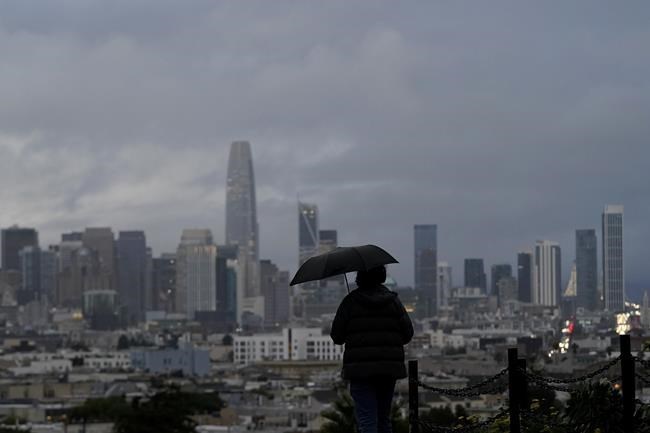LOS ANGELES (AP) — A powerful storm slid south through California on Tuesday, drenching the drought-stricken state with desperately needed rain but also triggering rescue efforts on a swollen river and mandatory evacuations due to the threat of mudslides in some areas scarred by wildfires.
The National Weather Service reported remarkable rainfall in several parts of the state.
North of the Golden Gate Bridge, Mount Tamalpais accumulated more than 11 inches (28 centimeters) over 72 hours. By early Tuesday, nearly 7 inches (18 centimeters) of rain had fallen in one area of Santa Barbara County, northwest of Los Angeles.
Los Angeles firefighters searched the surging Los Angeles River on Tuesday after discovering two submerged vehicles wedged against a bridge pillar south of downtown and learning that a third vehicle had been swept past the bridge. No victims, if any, were immediately located and firefighters were waiting for the water level to fall.
“The circumstances surrounding these three separate vehicles and their journey down the LA River remain unclear,” a Fire Department statement said.
Earlier, a man was rescued after being swept into a covered stream channel in the San Fernando Valley. The man called for help on his cellphone and firefighters reached him through a maintenance hole on the street above.
Residents near the Alisal Fire burn scar in Santa Barbara County were ordered Monday to evacuate over concerns that heavy rains might cause flooding and debris flows. Similar orders were issued for people living near burn scars in the San Bernardino Mountains east of Los Angeles and several Orange County canyons.
Avalanche warnings were in effect in the Mono and Inyo county areas of the eastern Sierra Nevada as snowfall, which began Sunday, continued Tuesday. Vail Resorts' three Lake Tahoe-area ski resorts opened late Tuesday morning after the significant snowfall. Spokesperson Sara Roston said Kirkwood Mountain Resort, which closed Monday for safety reasons, was among them.
The multiday storm, a powerful atmospheric river weather system that was sucking up moisture from the Pacific Ocean, dumped more than 6 feet (1.8 meters) of snow since Sunday night at the Mt. Rose ski resort just southwest of Reno and more than 4 feet (1.2 meters) at Heavenly on Lake Tahoe’s south shore.
The moisture is much-needed in the broader region that’s been gripped by drought that scientists have said is caused by climate change. The latest U.S. drought monitor shows parts of Montana, Oregon, California, Nevada and Utah are classified as being in exceptional drought, which is the worst category.
Most western U.S. reservoirs that deliver water to states, cities, tribes, farmers and utilities rely on melted snow in the springtime.
The soaking also brought relief from the threat of wildfires, which is significant into the late fall in Southern California.
The welcome rain didn’t stop Oakland resident and artist Zhenne Wood from walking her neighbor’s dog, a short-legged corgi.
“I decided to stay home today and not go anywhere, which is nice,” she said. “And I’m really happy for the rain. I think we needed it a lot.”
The storm prompted officials to shut down a 40-mile (64-kilometer) stretch of the iconic Highway 1 in California’s Big Sur area. The scenic coastal route south of the San Francisco Bay Area, frequently experiences damage during wet weather.
A second storm predicted to hit California midweek shortly after the current storm moves on could deliver almost continuous snow in mountainous areas, said Edan Weishahn of the weather service in Reno, which monitors an area straddling the Nevada state line.
___
Har reported from San Francisco. Associated Press writers Christopher Weber in Los Angeles, Terence Chea in Oakland and Scott Sonner in Reno contributed to this report.
John Antczak And Janie Har, The Associated Press



